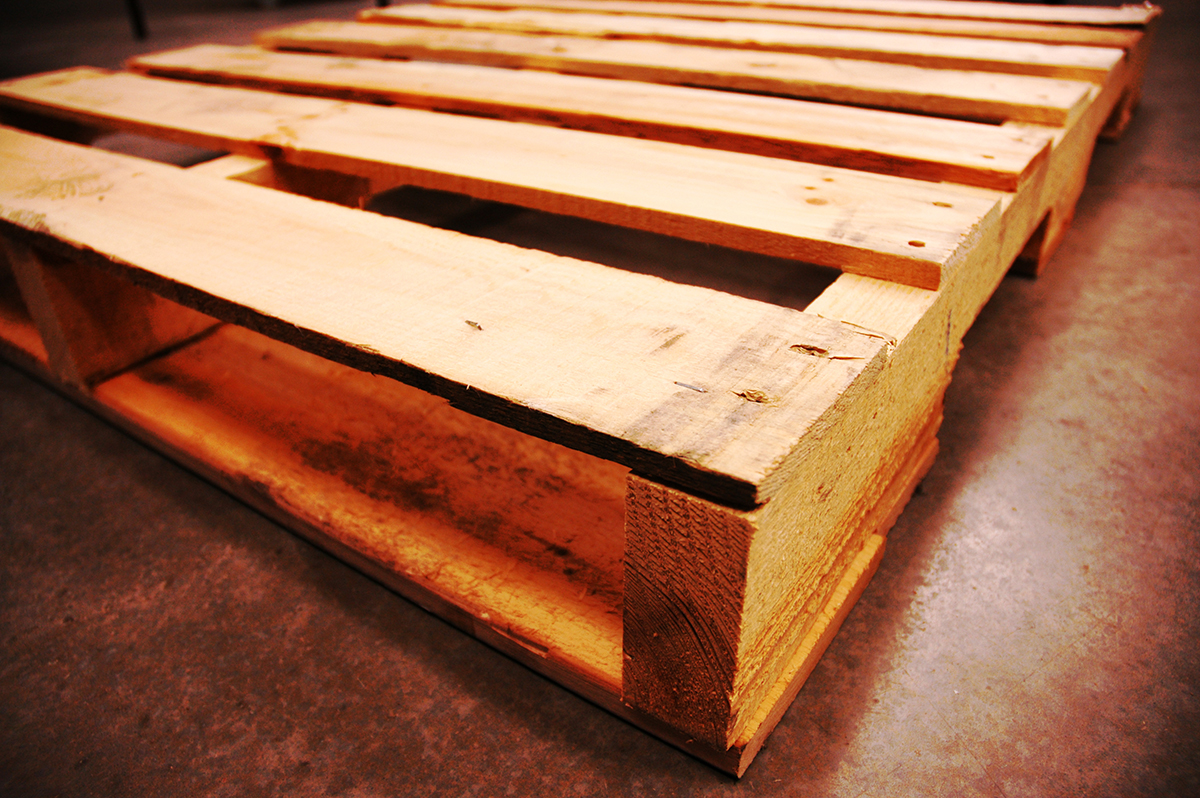How much does a pallet cost? As you might imagine, it is a question that we get asked a lot in our business. Many people believe that a pallet is a pallet and that the price is always the same, but nothing could be further from the truth. There are many considerations that go into answering the simple question of how much does a pallet cost.
Pallet pricing is influenced by many different factors.
For the purpose of this discussion, we’re only going to be looking at how much a pallet costs when it is a newly built wooden pallet. Recycled and refurbished wood pallets, as well as pallets made from other materials, have their own set of challenges that affect pricing.
1. The Price of Lumber
One of the biggest things that can affect how much a wood pallet costs is the price of lumber. At the moment, the industry is experiencing lumber shortages that are driving the price of lumber to record levels.
It’s a supply and demand issue.
Lumber supplies have been low since last summer, due to the pandemic, and mills haven’t caught up yet. When you add increased demand for lumber due to new housing starts, difficulties finding labor due to Federal unemployment policies, a surge in the DIY market, and even a beetle infestation in Canada, then everything gets out of balance and lumber prices go up.
Because the price of a new wood pallet depends on the cost of raw materials, the cost of lumber is the single most important factor affecting the cost of pallets. Other costs, such as labor and overhead, are mostly fixed, but commodities like lumber are determined by the market.
2. Amount of Lumber Used for Each Pallet
If the cost of a pallet is largely determined by the cost of raw materials, then it makes sense that the amount of raw materials used to make a particular pallet design also affects the price of the pallet.
Smaller pallets that use less lumber are obviously less costly than super-sized pallets that use a lot of lumber, but only if they are using the same type of wood and the same dimensional cuts of lumber.
Unfortunately, this is where the question of how much does a pallet cost gets even more complex.
3. Type of Lumber Used
Another one of the determining factors in the price of a pallet is the type of wood that is being used to build it. The majority of wood pallets are composed of southern yellow pine (SYP), but lots of other types of wood can also be used. For example, if a palletized load is very heavy, hardwoods may be used.
Remember, wood is a commodity that is affected by a lot of things in the market.
SYP is generally the go-to wood because it’s usually the least expensive option, but there are times when SYP is more expensive than hardwoods due to market conditions. A natural disaster, like a forest fire, can completely upend the market, as can political policies, and economic conditions.
Currently, we have a bunch of factors that have hit the lumber industry at the same time: the pandemic, massive fires in the Pacific Northwest, beetles in Canada, politics, and economic conditions. Frankly, we’re seeing unprecedented conditions in the market that have not only affected different types of lumber, but even different sizes – which is the next factor we’ll discuss.
4. What Sizes of Boards Are Needed for the Pallet
When a custom pallet is designed, different dimensions of boards are used for different parts of the pallet. A pallet might use 2×4 stringers and a plywood deck, 4×4 stringers and 2×4 deckboards, or hundreds of other combinations of board sizes. It all depends on the design, which is informed by the load size, weight, method of transport, etc.
Unfortunately, dimensional lumber can go through its own supply and demand challenges, in addition to the general demand in the market. The current lumber situation is a prime example.
With so many new homes being built, 2×4’s have become increasingly difficult to procure in the lower grades used to make pallets. Mills are so busy making the sizes of lumber used by builders, where they can command a higher price, that producing the lesser grades just isn’t a priority.
That leaves much less supply of #3 and #4 grade 2×4’s, and therefore makes them more costly to use. As a consequence, the cost of any pallet that uses 2×4’s is driven up.
5. Number and Type of Fasteners
As a commodity, the cost of lumber obviously affects how much a pallet costs, but there are a lot of other complex factors that can affect it too. One of those is the fasteners (staples, nails, screws, etc.) used to assemble each pallet. The metals used to make fasteners are obviously another commodity that can be affected by the market, but the number and types of fasteners used generally play a bigger role in pricing.
If you think about it, it makes sense that fasteners play a role in pricing. Staples generally cost less than screws, but if you use 20 staples where one screw could do the job, that might drastically change the pricing. On the other hand, it takes more labor and time to apply screws than it does to apply staples.
This is where working with your pallet designer can really pay off. They will be able to make sure you have a strong pallet that will protect your products as the lowest price possible, but it’s important to note that fasteners do affect the overall price of your pallet.
6. How Much Labor Required
For us here at Conner, we use machines for some tasks and labor for other tasks. Some pallets can be built on a machine, but other designs take several people doing multiple tasks on each pallet. Some of the custom pallets we build for our customers are pretty labor intensive, and that is a big contributing factor to the overall cost of pallet.
Using the example above regarding screws, it is more labor intensive to screw a fastener into a pallet than it is to use a staple or nail gun. Some pallets have to be flipped over multiple times to install different components, while others are so large that it takes a team of people to build each pallet. Sometimes jigs have to be created and machines have to be adjusted.
It all takes labor, and it must all be factored into the price of a pallet.
7. Volume of Pallets Ordered
The volume of pallets that you order can have a pretty big affect on the cost of each individual pallet, but that should be no surprise if you’ve ever shopped at a warehouse store. Buying in bulk is almost always less expensive, and that is certainly true for pallets as well.
It makes sense, if you think about it.
When you order a custom pallet, jigs have to be built and machines have to be adjusted for the design. Depending on complexity, this can take quite a bit of time. If you were ordering a single pallet, all that labor time would be built into the price of that single pallet. On the other hand, if you order in volume, that labor is accomplished one time, the expense is spread out over your entire order, and the per pallet price is lower.
It also becomes less expensive to assemble large volumes of pallets than it does a single pallet. Workers essentially set up an assembly line and start churning out pallets. Each person does one part of the assembly and then moves it to someone else who does another part. They are quick and efficient.
In contrast, when a single pallet is being assembled, it may just be one or two people working on it. They’ve never done your particular custom design before, so they are probably slower putting it together. Plus they are doing multiple parts of the assembly. It’s not as efficient of an operation and will take longer to build – making it more costly for each pallet.
This is the primary reason that we only work with volume customers. Building a singular custom pallet as a one-off is just too costly for us and for you.
8. Shipping
Although shipping isn’t technically part of determining how much a pallet costs, it certainly contributes to the overall price. Unfortunately, shipping is another one of those pricing components that can be affected by a lot of different factors. Everything from fuel costs and driver shortages, to shipping distance and volume shipped, can affect the cost of your pallets.
How Much Does A Pallet Cost?
We often get asked – How much does a pallet cost? Hopefully now you can see that this is a very complex and difficult question to answer without knowing more specifics about what your organization needs.
Obviously, design is a huge factor in determining the overall cost per pallet because it helps us determine many of the factors above – type of lumber, dimensions needed, fasteners, amount of labor required, volume, etc. Without getting very specific, we can’t tell you how much the pallet you need will cost your organization.
Pallet pricing can be very complex, and we want to make sure we’re giving you the best pricing possible.



![[PRESS RELEASE] Conner Industries Announces Major Guardian Packaging Expansion](https://conner.b-cdn.net/wp-content/uploads/2024/10/Guardian-Packaging-Expansion-500x383.jpg)
![[PRESS RELEASE] Conner Industries Announces Website Dedicated to Integrated Packaging Division](https://conner.b-cdn.net/wp-content/uploads/2024/05/Conner-Packaging-Blog-500x383.jpg)


